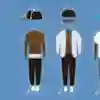Music fans have long copied whatever their stars are wearing, however outlandish, and hip hop is no different. Public Enemy were inspired by black nationalism and existentialism (see Flavor Flav's giant clocks), while Grandmaster Flash And The Furious Five had a penchant for rhinestone-studded jackets, tracksuits and bondage gear – sartorial statements that were emulated on the streets. After Beastie Boys' Mike D hung a VW badge from his neck, "being Beastied" became common parlance on news programmes after tens of thousands of the badges were stolen from cars across the US.
As hip-hop started out on the road to global domination in the early '90s, so its fashion became more accessible. Soon-to-be global superstars like Biggie Smalls, Nas and Jay-Z moved the look away from clock pendants and the Afrocentric style of De La Soul and A Tribe Called Quest and instead wore clothes inspired by everyday life – baggy jumpers, thick work jackets and sagging jeans. But this streetwear renaissance might not have happened without fashion brand Karl Kani and the brains behind it, Carl Williams.
Williams is in Berlin when we speak. He’s there to celebrate the launch of his new fall collection, and is failing to acclimatise to the German capital’s harsh winters. “I live in Los Angeles, so right now I’m wearing bubble coats, long johns and 10 ski hats,” he laughs.
Williams's story begins in Costa Rica, where he was born. At two years old, he and his family moved to the US, settling in Brooklyn. This was the early '70s: disco was beginning to reign supreme, but New York City was an ugly city on the brink of bankruptcy. Amid this backdrop, as Williams was finding his feet in his new home city, the first building blocks of hip-hop were being laid.
Williams was introduced to hip-hop like many millions of others were. "It was The Sugarhill Gang and Rapper’s Delight," he says excitedly, before breaking into an impromptu rap of the opening verse. The timing couldn’t have been better for a teenage Williams. Most people discovered hip-hop via records and MTV, but Williams had accidentally found himself front-row for the emergence of this new genre.
During these early years, B-Boys popped up all over NYC and Williams was one of them. At 13 years old, he wanted to be a rapper. He formed a crew, but was far too young to get into clubs at the time, so they made their own fun instead. “We’d always have house parties in somebody's basement or apartment. Those parties were so intimate and so real, and that's what brought the culture together. Hip-hop was the unity that brought people together."
Williams and his crew had the passion, but ultimately not the goods. “I wanted to be a rapper but people told me that I didn't have rhythm and that I couldn't dance," he says now. "I want to be at the forefront, but I couldn't get the lyrics down". He tried to become a DJ, too – DJ KK, to be exact – but that didn't work out either.
If Williams hadn’t become a globally-admired fashion designer this is where his story would end, but he was undeterred by his early hip-hop failures. “I still wanted to be part of the culture,” he says. “So, I thought: if I can't rap, then let me dress the rapper. That was my mission from the beginning.”
Williams was introduced to the idea of making his own clothes by his father, who had his own threads made by a tailor in Manhattan. “He didn't sew, he didn't know how to make a pattern, but he knew how to find people to get things done for him," he says. Later, through his teens, a healthy mix of ego and bravado helped him take this to the next stage. “Me and my friends were very competitive when it came to fashion. If I bought a new shoe or jacket, I would never tell my friends where I bought it from. I thought: OK, if that's the way you want to play the game, I'm going to make my own clothes. I went to my dad’s tailor and made my first outfit. All my friends thought it was so cool, asking where I got it from, and everybody wanted this outfit. So I said, 'If you want one, I'll make you one'.”
That first outfit set the template for Karl Kani. It was oversized, well-made, demanded a reaction, and, although he didn’t know it at the time, it saw Williams laying the foundations for modern streetwear. After word got around, Williams started flogging his wares in New York City nightclubs and on the street. At 19 years old, Williams was making custom clothing for kids in his local neighbourhood. He wasn’t making much money – “nothing I could retire on,” says Williams – but he was getting repped.
He quickly realised that his nascent clothing empire was missing something important – a brand name. “The most important day in my career came when I was sitting in a park,” he remembers. “A guy walked by wearing an outfit I made for him. I was bragging to these girls, saying ‘Hey, I made this guy’s outfit,’ but they didn't believe me. ‘Tell him to come over here,’ they said. He comes over and the girl asks to see his jacket, and she goes, ‘Well, if Carl made this, how come his name isn't on it?’ That's when it hit me. Her statement made me go home and figure out a brand name.”
'Can I' was a question I asked myself all the time. Can I be successful?
The son of a Costa Rican mother, Mariger, and Panamanian father, Perceval, his family changed its surname from a Spanish one to a US-sounding one after moving there. "Giorgio Armani, Donna Karan, Calvin Klein – those names have a ring to them," says Williams. “Carl Williams didn’t.” So he came up with Karl Kani – pronounced "Can-I".
“‘Can I' was a question I asked myself all the time,” he says. “Can I be successful? Can I come from the inner-city and build a clothing brand? Can I be international? I didn’t know the answers to that, but I knew that if I called myself Karl Kani, every day I'll have to answer that question. And, yes, I can.”
In 1989, with a name to his brand, Williams moved to California with “$1,000 and a pocket full of dreams”. Karl Kani didn't have the money to rope in a big name for their launch, so instead they chose a young student from New York City by the name of Sean Combs – later to be known as Puff Daddy, P Diddy, Diddy and whatever else – to be the face of their 1991 campaign.
Williams was just 23 at the time but in the same year, Karl Kani partnered with fashion label Cross Colours – a hip-hop inspired, politically-driven streetwear brand operating under the self-proclaimed ethos of "Clothing Without Prejudice". Almost overnight, Karl Kani was stocked in stores across the US.
“These stores bought our stuff based on the energy of hip-hop artists wearing our clothes in their music videos,” he says. “We saw the power of what happens when artists wear our stuff in videos and, as a result, that helped to build our business."
The demand for hip-hop streetwear suddenly exploded. Phat Farm and FUBU were founded in 1992; Wu-Tang Clan burst on to the scene wearing Polo Sport a year later; and everyone wanted Timberland boots. Once again, Williams found himself in the right place at the right time. This was the era of G-Funk, of East Coast vs West Coast rap, and the golden-age of modern R 'n' B. And if you were a star on the cover of The Source in the '90s, you were probably photographed in Williams' oversized, baggy denim.
During the height of Tupac’s fame, he was rarely seen without a Karl Kani logo across his chest. “I'm not going to charge you to wear your clothing, you're black; I don't charge my people for anything," he once told Williams, who spoke of his experiences with the LA rapper in a 2017 Billboard article. The list of Karl Kani’s famous fans goes on. In a move that was perhaps the only thing unifying the East and West Coast scenes at the time, Biggie Smalls appeared in campaigns for Karl Kani, while everyone from Nas and Aaliyah to Wu-Tang Clan and Snoop Dogg repped its signature-like logo.
Karl Kani even began influencing hip hop itself and the rhymes that were dominating the Billboard Top 100. “The d*** size in these Karl Kani jeans / I wear thirteens, know what I mean?” rhymed Biggie Smalls on One More Chance. “Some try to rap with that perpetrate mobster crap / Karl Kani jeans, fat stomachs in the limousines,” rapped Kool Keith on 1997’s Plastic World. And in the same year, Nelly paid homage on Steal The Show, with the line: “And I didn't have to get my whole team just to do that / In a blue hat, with a black baggy Karl Kani”.
“Eminem kind of made a joke from my name in a song once,” says Williams, recounting his favourite Kani-referencing lyric. That song was 1999’s Forgot About Dre. “The lyric goes: ‘One day I was walking by / With a Walkman on when I caught a guy / Give me an awkward eye / And I strangled him up in the parking lot with his Karl Kani'. At first, I was like, Eminem, why do you want to strangle me? But I thought it was pretty funny, and Eminem is crazy so you gotta accept it.”
At the time, Williams owned a multimillion dollar company and his clothes were being worn by the biggest stars in the world. He enjoyed all the perks that came with it, but looking back, he remains humble. “Money can't buy legacy, and it can't buy history," he says. “I never fed into any of the success that I had, and at the same time, I didn’t dwell on any of the failures that I had."
Williams believes that's why Karl Kani has remained a streetwear force for almost 30 years and why his designs continue to be repped by some of the biggest names in pop and hip hop. Migos, 2 Chainz, Justine Skye, Ariana Grande, Rihanna, Joey Bada$$ and Wolftyla (who wears vintage Karl Kani in the video above) – the list of big names wearing Karl Kani goes on and on.
But little has changed for that guy from Brooklyn still striving to make his mark. "I still find inspiration by watching what kids wear and doing my version of it,” says Williams. “Kids set trends, they know what's up. When you're connected to that, you're always going to be on top."







